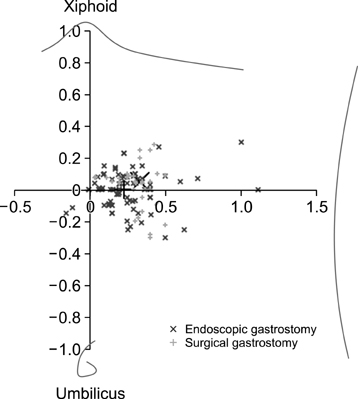Pediatr Gastroenterol Hepatol Nutr.
2017 Mar;20(1):34-40. 10.5223/pghn.2017.20.1.34.
Single Center Experience with Gastrostomy Insertion in Pediatric Patients: A 10-Year Review
- Affiliations
-
- 1Department of Pediatrics, Severance Children's Hospital, Yonsei University College of Medicine, Seoul, Korea. PEDKS@yuhs.ac
- KMID: 2375276
- DOI: http://doi.org/10.5223/pghn.2017.20.1.34
Abstract
- PURPOSE
This study was performed to review the outcomes of gastrostomy insertion in children at our institute during 10 years.
METHODS
A retrospective chart review was performed on 236 patients who underwent gastrostomy insertion from October 2005 to March 2015. We used our algorithm to select the least invasive method for gastrostomy insertion for each patient. Long-term follow-up was performed to analyze complications related to the method of gastrostomy insertion.
RESULTS
Out of 236 patients, 120 underwent endoscopic gastrostomy, 79 had laparoscopic gastrostomy, and 37 had open gastrostomy procedures. The total major complication rates for endoscopic gastrostomy insertion, laparoscopic gastrostomy insertion, and open gastrostomy were 9.2%, 8.9%, and 8.1%, respectively. The most common major complication was gastroesophageal reflux requiring Nissen fundoplication (3.8%), and other complications included peritonitis (1.3%), hiatal hernia (1.3%), and bowel perforation (0.8%). Gastrostomy removal was successful in 8.6% and 5.0% of patients in the endoscopic and surgical gastrostomy groups, respectively. Gastrocutaneous fistula occurred in 60% of surgically inserted cases, requiring a second operation.
CONCLUSION
This retrospective study was performed to review the outcome of gastrostomy insertion, as well as to introduce an algorithm that can be used for future cases. Further studies should be conducted to make a consensus on choosing the most appropriate method for gastrostomy insertion.
Keyword
MeSH Terms
Figure
Cited by 1 articles
-
Current status of nutritional support for hospitalized children: a nationwide hospital-based survey in South Korea
Seung Kim, Eun Hye Lee, Hye Ran Yang
Nutr Res Pract. 2018;12(3):215-221. doi: 10.4162/nrp.2018.12.3.215.
Reference
-
1. Braegger C, Decsi T, Dias JA, Hartman C, Kolacek S, Koletzko B, et al. Practical approach to paediatric enteral nutrition: a comment by the ESPGHAN committee on nutrition. J Pediatr Gastroenterol Nutr. 2010; 51:110–122.
Article2. Maitines G, Ugenti I, Memeo R, Clemente N, Iambrenghi OC. Endoscopic gastrostomy for enteral nutrition in neurogenic dysphagia: application of a nasogastric tube or percutaneous endoscopic gastrostomy. Chir Ital. 2009; 61:33–38.3. Stamm M. Gastrostomy by a new method. Med News. 1894; 65:324–326.4. Gauderer MW, Ponsky JL, Izant RJ Jr. Gastrostomy without laparotomy: a percutaneous endoscopic technique. J Pediatr Surg. 1980; 15:872–875.
Article5. Rothenberg SS, Bealer JF, Chang JH. Primary laparoscopic placement of gastrostomy buttons for feeding tubes. A safer and simpler technique. Surg Endosc. 1999; 13:995–997.
Article6. Georgeson KE. Laparoscopic fundoplication and gastrostomy. Semin Laparosc Surg. 1998; 5:25–30.
Article7. Grant JP. Comparison of percutaneous endoscopic gastrostomy with Stamm gastrostomy. Ann Surg. 1988; 207:598–603.
Article8. Zamakhshary M, Jamal M, Blair GK, Murphy JJ, Webber EM, Skarsgard ED. Laparoscopic vs percutaneous endoscopic gastrostomy tube insertion: a new pediatric gold standard? J Pediatr Surg. 2005; 40:859–862.
Article9. Liu R, Jiwane A, Varjavandi A, Kennedy A, Henry G, Dilley A, et al. Comparison of percutaneous endoscopic, laparoscopic and open gastrostomy insertion in children. Pediatr Surg Int. 2013; 29:613–621.
Article10. Gray BW, Ruzic A, Mychaliska GB. Gastrostomy in pediatric patients. In : Kohout P, editor. Gastrostomy. Rijeka, Croatia: INTECH;2011. p. 17–24.11. Vervloessem D, van Leersum F, Boer D, Hop WC, Escher JC, Madern GC, et al. Percutaneous endoscopic gastrostomy (PEG) in children is not a minor procedure: risk factors for major complications. Semin Pediatr Surg. 2009; 18:93–97.
Article12. Gauderer MW. Percutaneous endoscopic gastrostomy: a 10-year experience with 220 children. J Pediatr Surg. 1991; 26:288–292. discussion 292-4.
Article13. Beasley SW, Catto-Smith AG, Davidson PM. How to avoid complications during percutaneous endoscopic gastrostomy. J Pediatr Surg. 1995; 30:671–673.
Article14. Cosentini EP, Sautner T, Gnant M, Winkelbauer F, Teleky B, Jakesz R. Outcomes of surgical, percutaneous endoscopic, and percutaneous radiologic gastrostomies. Arch Surg. 1998; 133:1076–1083.
Article15. Herrmann M. Algorithm for techniques of gastrostomy tube placement. Surg Endosc. 2000; 14:970–971. author reply 972-3.
Article16. Rabeneck L, McCullough LB, Wray NP. Ethically justified, clinically comprehensive guidelines for percutaneous endoscopic gastrostomy tube placement. Lancet. 1997; 349:496–498.
Article17. Heine RG, Reddihough DS, Catto-Smith AG. Gastrooesophageal reflux and feeding problems after gastrostomy in children with severe neurological impairment. Dev Med Child Neurol. 1995; 37:320–329.
Article18. Samuel M, Holmes K. Quantitative and qualitative analysis of gastroesophageal reflux after percutaneous endoscopic gastrostomy. J Pediatr Surg. 2002; 37:256–261.
Article19. Hament JM, Bax NM, van der Zee DC, De Schryver JE, Nesselaar C. Complications of percutaneous endoscopic gastrostomy with or without concomitant antireflux surgery in 96 children. J Pediatr Surg. 2001; 36:1412–1415.
Article20. El-Rifai N, Michaud L, Mention K, Guimber D, Caldari D, Turck D, et al. Persistence of gastrocutaneous fistula after removal of gastrostomy tubes in children: prevalence and associated factors. Endoscopy. 2004; 36:700–704.
Article
- Full Text Links
- Actions
-
Cited
- CITED
-
- Close
- Share
- Similar articles
-
- Technique, Management and Complications of Percutaneous Endoscopic Gastrostomy
- Percutaneous Gastrostomy Tube Reinsertion after Accidental Dislodgement Using Modified Seldinger's Technique
- Patients Requiring Gastrostomy Tube Insertion After Total Laryngectomy Have a Higher Incidence of Otitis Media
- Two Cases of Early Onset Acute Buried Bumper Syndrome after Percutaneous Endoscopic Gastrostomy
- Percutaneous Endoscopic Gastrostomy Tube Insertion in Neurodegenerative Disease: A Retrospective Study and Literature Review



